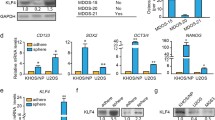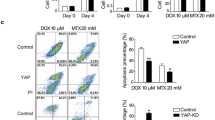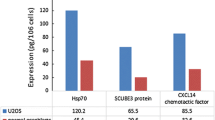Abstract
Kruppel-like factor 6 (KLF6) is a tumor suppressor gene frequently downregulated in a number of human cancers, including osteosarcoma. However, the role of KLF6 in osteosarcoma remains unclear. This study was aimed at investigating the effects of KLF6 on osteosarcoma cell biological behavior. First, the expression of KLF6 in osteosarcoma cell lines (MG63, SaOS-2, U2OS, and HOS) and a human osteoblastic cell line (hFOB1.19) was detected by Western blotting. Results showed that KLF6 displayed a significant downregulation in osteosarcoma cell lines (MG63, SaOS-2, U2OS, and HOS) compared with human osteoblastic cell line (hFOB1.19). To investigate the role of KLF6 in osteosarcoma cell proliferation, apoptosis, and invasion, we generated human osteosarcoma MG63 cells in which KLF6 was either overexpressed or depleted. The MG63 cell viability, cycle, apoptosis, and invasive ability were analyzed by 3-(4,5-dimethylthiazol-2-yl)-2,5-diphenyltetrazolium bromide staining, propidium iodide (PI) staining, Annexin-V-FITC/PI double staining, and Transwell invasion experiment, respectively. Results showed that the viability, proliferation, and invasive abilities were suppressed, and the apoptosis was enhanced in MG63 cells with overexpression of KLF6. The viability, proliferation, and invasive abilities were improved, and the apoptosis was inhibited in MG63 cells with knockdown of KLF6. At the same time, these molecules, including p21, bcl-2, and MMP-9, associated with the events about cell cycle, apoptosis, and invasion, were detected. Results showed that the expressions of bcl-2 and MMP-9 were downregulated, and the expressions of p21 were upregulated in the MG-63 cells with overexpression of KLF6. Taken together, our results suggested that KLF6 could inhibit proliferation and invasion, and facilitate apoptosis of osteosarcoma cells, which might be a potential target for the treatment of osteosarcoma.






Similar content being viewed by others
Reference
Janeway KA, Walkley CR. Modeling human osteosarcoma in the mouse: from bedside to bench. Bone. 2010;47(5):859–65.
Harting MT, Blakely ML. Management of osteosarcoma pulmonary metastases. Semin Pediatr Surg. 2006;15(1):25–9.
PosthumaDeBoer J, Witlox MA, Kaspers GJ, van Royen BJ. Molecular alterations as target for therapy in metastatic osteosarcoma: a review of literature. Clin Exp Metastasis. 2011;28(5):493–503.
Yao C, Wei JJ, Wang ZY, Ding HM, Li D, Yan SC, et al. Perifosine induces cell apoptosis in human osteosarcoma cells: new implication for osteosarcoma therapy? Cell Biochem Biophys. 2012. doi:10.1007/s12013-012-9423-5.
Chen C, Hyytinen ER, Sun X, Helin HJ, Koivisto PA, Frierson Jr HF, et al. Deletion, mutation, and loss of expression of KLF6 in human prostate cancer. Am J Pathol. 2003;162(4):1349–54.
Simmen RC, Pabona JM, Velarde MC, Simmons C, Rahal O, Simmen FA. The emerging role of Kruppel-like factors in endocrine-responsive cancers of female reproductive tissues. J Endocrinol. 2010;204(3):223–31.
Bieker JJ. Kruppel-like factors: three fingers in many pies. J Biol Chem. 2001;276(37):34355–8.
Black AR, Black JD, Azizkhan-Clifford J. Sp1 and kruppel-like factor family of transcription factors in cell growth regulation and cancer. J Cell Physiol. 2001;188(2):143–60.
Narla G, Friedman SL, Martignetti JA. Kruppel cripples prostate cancer: KLF6 progress and prospects. Am J Pathol. 2003;162(4):1047–52.
Ratziu V, Lalazar A, Wong L, Dang Q, Collins C, Shaulian E, et al. Zf9, a Kruppel-like transcription factor up-regulated in vivo during early hepatic fibrosis. Proc Natl Acad Sci U S A. 1998;95(16):9500–5.
DiFeo A, Martignetti JA, Narla G. The role of KLF6 and its splice variants in cancer therapy. Drug Resist Updat. 2009;12(1–2):1–7.
Liu X, Gomez-Pinillos A, Loder C. Carrillo-de Santa Pau E, Qiao R, Unger PD, et al. KLF6 loss of function in human prostate cancer progression is implicated in resistance to androgen deprivation. Am J Pathol. 2012;181(3):1007–16.
Munoz U, Puche JE, Hannivoort R, Lang UE, Cohen-Naftaly M, Friedman SL. Hepatocyte growth factor enhances alternative splicing of the Kruppel-like factor 6 (KLF6) tumor suppressor to promote growth through SRSF1. Mol Cancer Res. 2012;10(9):1216–27.
Hartel M, Narla G, Wente MN, Giese NA, Martignoni ME, Martignetti JA, et al. Increased alternative splicing of the KLF6 tumour suppressor gene correlates with prognosis and tumour grade in patients with pancreatic cancer. Eur J Cancer. 2008;44(13):1895–903.
Narla G, Heath KE, Reeves HL, Li D, Giono LE, Kimmelman AC, et al. KLF6, a candidate tumor suppressor gene mutated in prostate cancer. Science. 2001;294(5551):2563–6.
Hanoun N, Bureau C, Diab T, Gayet O, Dusetti N, Selves J, et al. The SV2 variant of KLF6 is down-regulated in hepatocellular carcinoma and displays anti-proliferative and pro-apoptotic functions. J Hepatol. 2010;53(5):880–8.
Tarocchi M, Hannivoort R, Hoshida Y, Lee UE, Vetter D, Narla G, et al. Carcinogen-induced hepatic tumors in KLF6+/− mice recapitulate aggressive human hepatocellular carcinoma associated with p53 pathway deregulation. Hepatology. 2011;54(2):522–31.
Chen H, Chen L, Sun L, Zhen H, Li X, Zhang Q. A small interfering RNA targeting the KLF6 splice variant, KLF6-SV1, as gene therapy for gastric cancer. Gastric Cancer. 2011;14(4):339–52.
Fleischer M, Kessler R, Klammer A, Warnke JP, Eschrich K. LOH on 10p14-p15 targets the PFKFB3 gene locus in human glioblastomas. Genes Chromosomes Cancer. 2011;50(12):1010–20.
Saunders IW, Ross J, Macrae F, Young GP, Blanco I, Brohede J, et al. Evidence of linkage to chromosomes 10p15.3-p15.1, 14q24.3-q31.1 and 9q33.3-q34.3 in non-syndromic colorectal cancer families. Eur J Hum Genet. 2012;20(1):91–6.
Wahab AH, Kassem AM, Matter S, El Deen AF, Helmy AS, Ismaeil MM, et al. Role of KLF6 tumor suppressor gene mutations in the development of colorectal carcinoma in an Egyptian population. Hepatogastroenterology. 2010;57(104):1405–10.
Zhang X, Nie Y, Du Y, Cao J, Shen B, Li Y. MicroRNA-181a promotes gastric cancer by negatively regulating tumor suppressor KLF6. Tumour Biol. 2012. doi:10.1007/s13277-012-0414-3.
Chen K, Chen Y, Zhu XD, Bai YS, Wei XZ, Wang CF, et al. Expression and significance of Kruppel-like factor 6 gene in osteosarcoma. Int Orthop. 2012;36(10):2107–11.
Wang HJ, Ruan HJ, He XJ, Ma YY, Jiang XT, Xia YJ, et al. MicroRNA-101 is down-regulated in gastric cancer and involved in cell migration and invasion. Eur J Cancer. 2010;46(12):2295–303.
Su Y, Wang F, Zhou D, Gao W, Hu Q, Cui H, et al. Inhibition of proliferation of rat lens epithelial cell by overexpression of KLF6. Mol Vis. 2011;17:1080–4.
Ghiassi-Nejad Z, Hernandez-Gea V, Woodrell C, Lang UE, Dumic K, Kwong A, et al. Reduced hepatic stellate cell expression of KLF6 tumor suppressor isoforms amplifies fibrosis during acute and chronic rodent liver injury. Hepatology. 2012. doi:10.1002/hep.26056.
Hockenbery D, Nunez G, Milliman C, Schreiber RD, Korsmeyer SJ. Bcl-2 is an inner mitochondrial membrane protein that blocks programmed cell death. Nature. 1990;348(6299):334–6.
Kiang JG, Agravante NG, Smith JT, Bowman PD. 17-DMAG diminishes hemorrhage-induced small intestine injury by elevating Bcl-2 protein and inhibiting iNOS pathway, TNF-alpha increase, and caspase-3 activation. Cell Biosci. 2011;1(1):21.
Lin HP, Jiang SS, Chuu CP. Caffeic acid phenethyl ester causes p21 induction, Akt signaling reduction, and growth inhibition in PC-3 human prostate cancer cells. PLoS One. 2012;7(2):e31286.
Gong MZ, You JF, Pei F, Cui XL, Li G, Zheng J. Transcriptional activation of TMSG-1 by complex of KLF6 and Sp1. Zhonghua Bing Li Xue Za Zhi. 2011;40(8):542–8.
DiFeo A, Narla G, Camacho-Vanegas O, Nishio H, Rose SL, Buller RE, et al. E-cadherin is a novel transcriptional target of the KLF6 tumor suppressor. Oncogene. 2006;25(44):6026–31.
Miyaki M, Yamaguchi T, Iijima T, Funata N, Mori T. Difference in the role of loss of heterozygosity at 10p15 (KLF6 locus) in colorectal carcinogenesis between sporadic and familial adenomatous polyposis and hereditary nonpolyposis colorectal cancer patients. Oncology. 2006;71(1–2):131–5.
Das A, Fernandez-Zapico ME, Cao S, Yao J, Fiorucci S, Hebbel RP, et al. Disruption of an SP2/KLF6 repression complex by SHP is required for farnesoid X receptor-induced endothelial cell migration. J Biol Chem. 2006;281(51):39105–13.
Acknowledgment
This study was supported by Nantong City Social Development Science and Technology Project (Grant no. s2010015), and by Six Personnel Peak Project of Jiangsu Province (Grant no. 2011-WS-119).
Conflicts of interest
None
Author information
Authors and Affiliations
Corresponding author
Rights and permissions
About this article
Cite this article
Jianwei, Z., Enzhong, B., Fan, L. et al. Effects of Kruppel-like factor 6 on osteosarcoma cell biological behavior. Tumor Biol. 34, 1097–1105 (2013). https://doi.org/10.1007/s13277-013-0651-0
Received:
Accepted:
Published:
Issue Date:
DOI: https://doi.org/10.1007/s13277-013-0651-0




